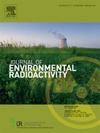气象研究预报模式中背景源和地形分辨率对监测站氙羽特征的影响
IF 2.1
3区 环境科学与生态学
Q3 ENVIRONMENTAL SCIENCES
引用次数: 0
摘要
对于许多大气监测应用,测量站网络——例如国际监测系统的放射性核素站——可能是稀疏的。由于测量地点可能距离释放点数百至数千公里,因此量化物理过程对源和测量地点之间羽流传输和扩散的影响非常重要。本研究讨论了背景源和地形分辨率对放射性核素释放位置附近的影响。我们使用天气研究与预报(WRF)模型和内联化学来研究(1)额外的、时变的133Xe源,如运行的医疗同位素生产设施,如何有助于监测站点的活动浓度测量,以及(2)复杂地形对排放源附近大气条件的影响如何影响距离源不同距离的羽流浓度。模拟了两个133Xe发射源,包括(1)代表爆炸事件的短持续时间的高通量源和(2)可变和连续的背景源。连续本底源对几个监测站的总133Xe浓度有显著贡献。此外,将水平分辨率为9 km的WRF模拟与嵌套网格模拟进行了比较,其中最内层域的分辨率为1 km。地形分辨率的提高改善了羽流对当地风的响应,离源最近的地方地形影响最大。距离源越远,两种域分辨率之间的差异就越小,因为羽流有时间扩散和混合,并受到天气尺度环流模式的影响,这在两个模拟中表现得相似。本文章由计算机程序翻译,如有差异,请以英文原文为准。
Influence of background sources and topographic resolution in the Weather Research and Forecasting Model on xenon plume characteristics at monitoring stations
For many atmospheric monitoring applications, networks of measurement sites—such as the radionuclide stations of the International Monitoring System—can be sparse. With measurement locations potentially hundreds to thousands of kilometers from a release it is important to quantify the effects of physical processes on transport and dispersion of plumes between source and measurement locations. This study addresses the effects of background sources and topography resolution near the release location of radionuclides. We use the Weather Research and Forecasting (WRF) model with inline chemistry to investigate (1) how an additional, time-varying source of 133Xe, such as an operational medical isotope production facility, contributes to activity concentration measurements at monitoring sites, and (2) how complex topography influences on atmospheric conditions near emission sources impact plume concentrations at varying distances from the source. Two 133Xe emission sources, including (1) a high flux rate of short duration representing an explosive event, and (2) a variable and continuous background source, are simulated. The continuous background source contributes significantly to total 133Xe concentrations at several monitoring stations. Further, a WRF simulation at 9 km horizontal resolution is compared with a nested grid simulation, where the innermost domain has a resolution of 1 km. Increased topographic resolution leads to an improved representation of plume responses to local winds, with topographic influences greatest at locations closest to the sources. Differences between the two domain resolutions decrease at greater distances from the sources, as plumes have time to spread and mix and are influenced by synoptic scale circulation patterns that are represented similarly in both simulations.
求助全文
通过发布文献求助,成功后即可免费获取论文全文。
去求助
来源期刊

Journal of environmental radioactivity
环境科学-环境科学
CiteScore
4.70
自引率
13.00%
发文量
209
审稿时长
73 days
期刊介绍:
The Journal of Environmental Radioactivity provides a coherent international forum for publication of original research or review papers on any aspect of the occurrence of radioactivity in natural systems.
Relevant subject areas range from applications of environmental radionuclides as mechanistic or timescale tracers of natural processes to assessments of the radioecological or radiological effects of ambient radioactivity. Papers deal with naturally occurring nuclides or with those created and released by man through nuclear weapons manufacture and testing, energy production, fuel-cycle technology, etc. Reports on radioactivity in the oceans, sediments, rivers, lakes, groundwaters, soils, atmosphere and all divisions of the biosphere are welcomed, but these should not simply be of a monitoring nature unless the data are particularly innovative.
 求助内容:
求助内容: 应助结果提醒方式:
应助结果提醒方式:


